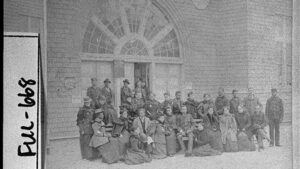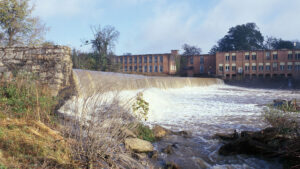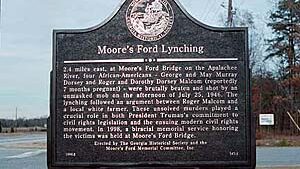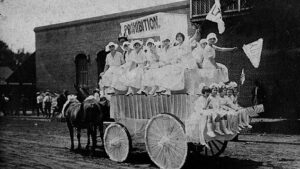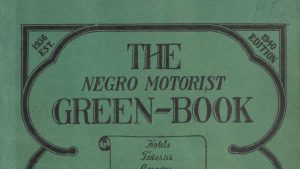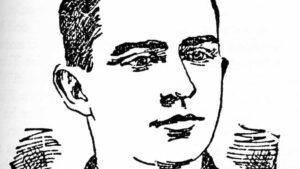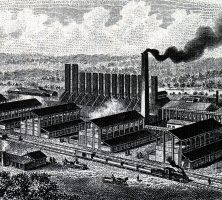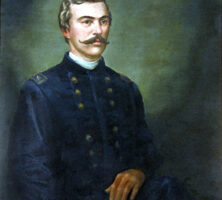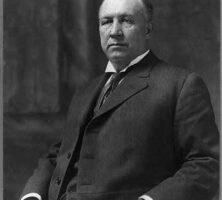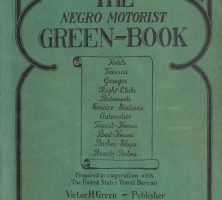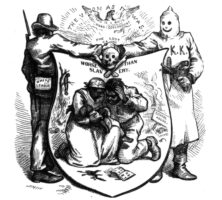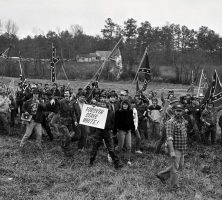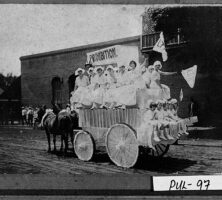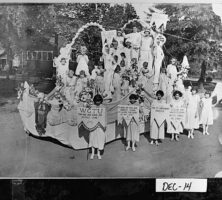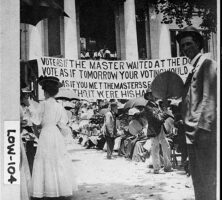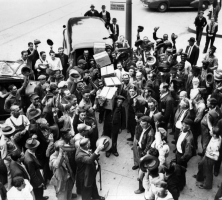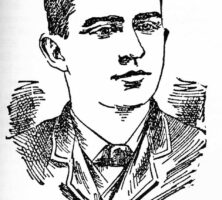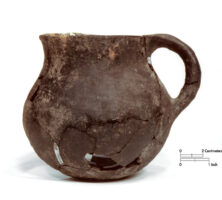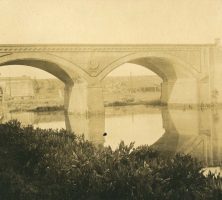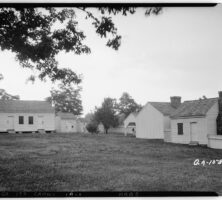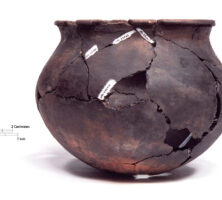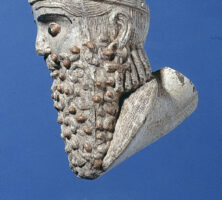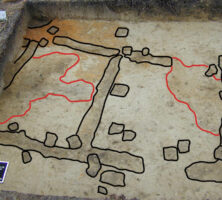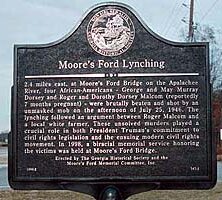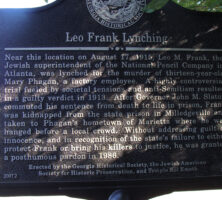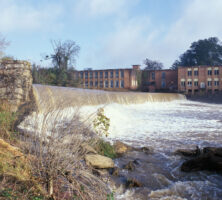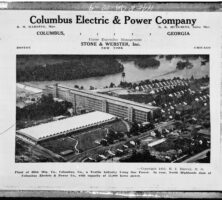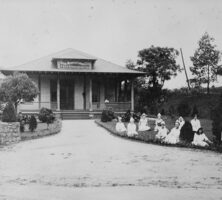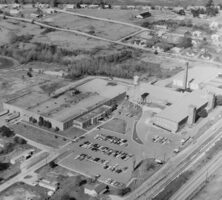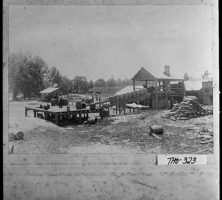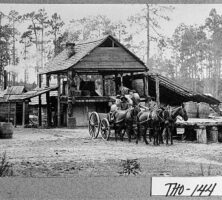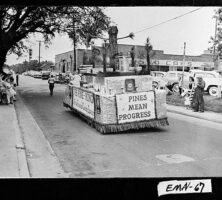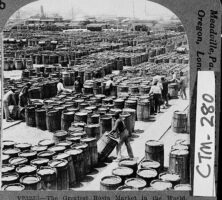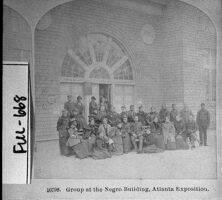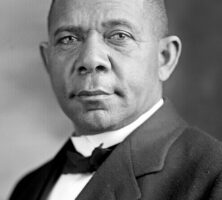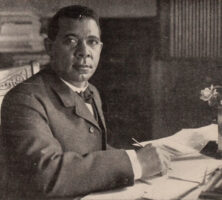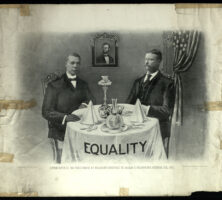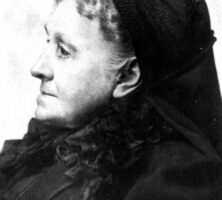The New Georgia Encyclopedia is supported by funding from A More Perfect Union, a special initiative of the National Endowment for the Humanities.
The Chattahoochee Brick Company was among the largest and most notorious employers of convict labor in Georgia. Under the terms of the convict lease system, Chattahoochee Brick forced thousands of Black Georgians to labor under conditions that have been described as industrial slavery.
Courtesy of Atlanta History Center.
The New Georgia Encyclopedia does not hold the copyright for this media resource and can neither grant nor deny permission to republish or reproduce the image online or in print. Requests for permission to publish or reproduce the resource should be submitted to the Atlanta History Center.
Thomas Ruger, a Union officer, was appointed military provisional governor of Georgia in 1868, during Reconstruction. During his six-month tenure, Ruger instituted the state's convict lease system.
Courtesy of Georgia Capitol Museum, University of Georgia Libraries
The New Georgia Encyclopedia does not hold the copyright for this media resource and can neither grant nor deny permission to republish or reproduce the image online or in print. All requests for permission to publish or reproduce the resource must be submitted to the rights holder.
Formed as the result of several mergers, First National Bank of Atlanta (or First Atlanta) was the largest U.S. bank south of Philadelphia in 1929. The First National Bank Building served as First Atlanta's headquarters.
Courtesy of Wachovia Corporation
The New Georgia Encyclopedia does not hold the copyright for this media resource and can neither grant nor deny permission to republish or reproduce the image online or in print. All requests for permission to publish or reproduce the resource must be submitted to the rights holder.
Hoke Smith poses for a portrait in 1912, the year after his second term as Georgia's governor had ended. Smith served as governor first from 1907 to 1909 and then again in 1911, until he was selected to fill the empty U.S. Senate seat of Joseph M. Terrell. He remained in this seat until 1921.
Courtesy of Library of Congress, Prints and Photographs Division
The New Georgia Encyclopedia does not hold the copyright for this media resource and can neither grant nor deny permission to republish or reproduce the image online or in print. All requests for permission to publish or reproduce the resource must be submitted to the rights holder.
The Negro Motorist Green-Book, also known as the Negro Traveller's Green-Book, was an essential guide for Black travelers between 1936 and 1966. This yearly publication, created by postal employee Victor Hugo Green, helped readers avoid sundown towns and locate safe lodging, gas stops, and eateries.
From Wikimedia
The New Georgia Encyclopedia does not hold the copyright for this media resource and can neither grant nor deny permission to republish or reproduce the image online or in print. All requests for permission to publish or reproduce the resource must be submitted to the rights holder.
Most Ku Klux Klan action was designed to intimidate Black voters and white supporters of the Republican Party. Founded in Tennessee in 1866, the Klan was particularly active in Georgia from 1868 to the early 1870s.
From Harper's Weekly
The New Georgia Encyclopedia does not hold the copyright for this media resource and can neither grant nor deny permission to republish or reproduce the image online or in print. All requests for permission to publish or reproduce the resource must be submitted to the rights holder.
White supremacists picketing at the first Brotherhood March on January 17, 1987, in Forsyth County.
Courtesy of Atlanta Journal-Constitution, Atlanta Journal-Constitution Photographic Archive, #AJCNS1987-01-17l.
The New Georgia Encyclopedia does not hold the copyright for this media resource and can neither grant nor deny permission to republish or reproduce the image online or in print. All requests for permission to publish or reproduce the resource must be submitted to the Atlanta Journal-Constitution.
Young women and children ride on a parade float promoting prohibition in Hawkinsville (Pulaski County), circa 1919.
Courtesy of Georgia Archives, Vanishing Georgia, #
pul097a.
The New Georgia Encyclopedia does not hold the copyright for this media resource and can neither grant nor deny permission to republish or reproduce the image online or in print. Requests for permission to publish or reproduce the resource should be submitted to the Georgia Archives.
Women's Christian Temperance Movement (WTCU) members participate in the Decatur County centennial parade in Bainbridge, 1923. The WCTU formed its first Georgia chapter in 1880. Largely due to their efforts, Georgia passed a local option law in 1885.
Courtesy of Georgia Archives, Vanishing Georgia, #
dec014.
The New Georgia Encyclopedia does not hold the copyright for this media resource and can neither grant nor deny permission to republish or reproduce the image online or in print. Requests for permission to publish or reproduce the resource should be submitted to the Georgia Archives.
A crowd gathered in front of the Lowndes County courthouse in Valdosta for a prohibition vote in 1907. That year, Georgia became the first state in the South to pass a statewide ban on the production, transportation, and sale of alcohol.
Courtesy of Georgia Archives, Vanishing Georgia, #
low104.
The New Georgia Encyclopedia does not hold the copyright for this media resource and can neither grant nor deny permission to republish or reproduce the image online or in print. Requests for permission to publish or reproduce the resource should be submitted to the Georgia Archives.
A crowd in Marietta celebrates the end of prohibition. In 1935 the Georgia legislature approved the Alcoholic Beverage Control Act, which called for a statewide referendum on the issue of repeal and tasked the State Revenue Commission with drafting new regulations to govern the sale and distribution of alcohol.
Courtesy of Special Collections & Archives, Georgia State University Library, Atlanta Journal-Constitution Photographic Archive.
The New Georgia Encyclopedia does not hold the copyright for this media resource and can neither grant nor deny permission to republish or reproduce the image online or in print. Requests for permission to publish or reproduce the resource should be submitted to Special Collections and Archives at Georgia State University.
Thomas G. Woolfolk was convicted and hanged for murdering nine members of his family in their Bibb County home on August 6, 1887. This drawing, adapted from a photograph taken of Woolfolk in the jail at Macon, appeared in the Oglethorpe Echo newspaper on November 7, 1890, about a week after his execution.
Drawing from Oglethorpe Echo
The New Georgia Encyclopedia does not hold the copyright for this media resource and can neither grant nor deny permission to republish or reproduce the image online or in print. All requests for permission to publish or reproduce the resource must be submitted to the rights holder.
Nine members of the Woolfolk family were murdered in their Bibb County home on August 6, 1887, by relative Thomas G. Woolfolk. The victims are buried together at Rose Hill Cemetery in Macon.
Photograph by amanderson2
The New Georgia Encyclopedia does not hold the copyright for this media resource and can neither grant nor deny permission to republish or reproduce the image online or in print. All requests for permission to publish or reproduce the resource must be submitted to the rights holder.
The New Georgia Encyclopedia does not hold the copyright for this media resource and can neither grant nor deny permission to republish or reproduce the image online or in print. All requests for permission to publish or reproduce the resource must be submitted to the rights holder.
Unrestored shotgun houses line a street in Macon. The shotgun, a rectangular house type that is one room wide and two to four rooms deep, may have developed from a West African architectural tradition.
Courtesy of Elizabeth Lyon
The New Georgia Encyclopedia does not hold the copyright for this media resource and can neither grant nor deny permission to republish or reproduce the image online or in print. All requests for permission to publish or reproduce the resource must be submitted to the rights holder.
Colonoware, a form of earthenware pottery, was made by African Americans on plantations in Georgia, North Carolina, and South Carolina. Produced circa 1740, this pitcher was found during an exacavation in Charleston, South Carolina, during the late 1990s.
Courtesy of New South Associates
The New Georgia Encyclopedia does not hold the copyright for this media resource and can neither grant nor deny permission to republish or reproduce the image online or in print. All requests for permission to publish or reproduce the resource must be submitted to the rights holder.
The Savannah-Ogeechee Canal, pictured circa 1888, was completed by enslaved laborers in 1829.
Courtesy of Georgia Historical Society, James S. Silva family papers, #GHS 2126-VM01-04 pg072.
The New Georgia Encyclopedia does not hold the copyright for this media resource and can neither grant nor deny permission to republish or reproduce the image online or in print. All requests for permission to publish or reproduce the resource must be submitted to Georgia Historical Society.
Slave quarters, pictured in 1936, stand at Liberty Hall in Taliaferro County, the homeplace of Georgia governor Alexander Stephens. African American structures on Georgia plantations were generally rectangular in shape, as opposed to the square forms preferred by Europeans.
Courtesy of Library of Congress, Prints and Photographs Division, Historic American Buildings Survey.
The New Georgia Encyclopedia does not hold the copyright for this media resource and can neither grant nor deny permission to republish or reproduce the image online or in print. All requests for permission to publish or reproduce the resource must be submitted to the rights holder.
This colonoware jar, uncovered in South Carolina in the 1990s, dates to the mid-eighteenth century. Colonoware was made by African Americans on coastal plantations and has been found on several Georgia sites.
Courtesy of New South Associates
The New Georgia Encyclopedia does not hold the copyright for this media resource and can neither grant nor deny permission to republish or reproduce the image online or in print. All requests for permission to publish or reproduce the resource must be submitted to the rights holder.
Dating to the 1850s, this Ninevian pipe was uncovered during an archaeological excavation conducted between 1989 and 1991 at the Springfield site near Augusta. The Springfield village was populated by free Blacks before the end of slavery in 1865.
Courtesy of New South Associates
The New Georgia Encyclopedia does not hold the copyright for this media resource and can neither grant nor deny permission to republish or reproduce the image online or in print. All requests for permission to publish or reproduce the resource must be submitted to the rights holder.
The outline of a wall trench was uncovered by archaeologists in 2000 at the Silk Hope Plantation, an eighteenth-century rice plantation in Bryan County. The markings in black show the locations of a wall trench and post features that form a slave dwelling, and the red outline shows the presence of pit features that were used for storage and other functions.
Courtesy of Brockington and Associates
The New Georgia Encyclopedia does not hold the copyright for this media resource and can neither grant nor deny permission to republish or reproduce the image online or in print. All requests for permission to publish or reproduce the resource must be submitted to the rights holder.
A historical marker, erected by the Georgia Historical Society, stands on the site of a mass lynching, which took place in 1946 on the border of Walton and Oconee counties. The crime generated national attention and led to U.S. president Harry Truman's creation of the President's Committee on Civil Rights.
Courtesy of Georgia Info, Digital Library of Georgia.
The New Georgia Encyclopedia does not hold the copyright for this media resource and can neither grant nor deny permission to republish or reproduce the image online or in print. Requests for permission to publish or reproduce the resource may need to be submitted to the Digital Library of Georgia.
A historical marker stands near the site of Leo Frank's lynching in Cobb County. Dedicated in March 2008, the marker was erected by the Georgia Historical Society, the Jewish American Society for Historic Preservation, and Temple Kol Emeth.
Courtesy of Georgia Historical Society, Historical Marker Program.
The New Georgia Encyclopedia does not hold the copyright for this media resource and can neither grant nor deny permission to republish or reproduce the image online or in print. All requests for permission to publish or reproduce the resource must be submitted to Georgia Historical Society.
In 1916 Bibb Manufacturing Company opened the Osprey Mill in Porterdale. Bibb was an important part of Georgia's cotton and textile industry for more than a century and became one of the state's largest employers by the mid-1950s.
The New Georgia Encyclopedia does not hold the copyright for this media resource and can neither grant nor deny permission to republish or reproduce the image online or in print. Requests for permission to publish or reproduce the resource may need to be submitted to the Georgia Department of Community Affairs, Historic Preservation Division.
The Columbus Mill was built by the Bibb Manufacturing Company in 1900 on the banks of the Chattahoochee River. Eventually the cotton mill grew to be the largest in the country, supporting a mill town known as "Bibb City."
Courtesy of Library of Congress, Prints and Photographs Division, Historic American Engineering Record, #HAER GA,108-COLM,27-10.
The New Georgia Encyclopedia does not hold the copyright for this media resource and can neither grant nor deny permission to republish or reproduce the image online or in print. All requests for permission to publish or reproduce the resource must be submitted to the rights holder.
The Bibb Manufacturing Company, founded in Macon in 1876, opened mills in a number of Georgia communities by the end of the nineteenth century. In 1905 the company opened a free kindergarten in Covington, believed to be the first such program in Newton County.
Courtesy of Georgia Archives, Vanishing Georgia, #new142-83.
The New Georgia Encyclopedia does not hold the copyright for this media resource and can neither grant nor deny permission to republish or reproduce the image online or in print. Requests for permission to publish or reproduce the resource should be submitted to the Georgia Archives.
After World War II, the Bibb Manufacturing Company opened several new mills in Georgia, including its Forsyth Mill, pictured in the 1970s. During the 1950s, Bibb became one of the largest employers in the state, and by 1966 the company operated fourteen mills in Georgia.
Courtesy of Georgia Archives, Vanishing Georgia, # mnr184.
The New Georgia Encyclopedia does not hold the copyright for this media resource and can neither grant nor deny permission to republish or reproduce the image online or in print. Requests for permission to publish or reproduce the resource should be submitted to the Georgia Archives.
A Thomas County turpentine still produces rosin and turpentine in the early 1900s. Along with other naval stores products, rosin and turpentine were used in the construction and repair of sea vessels.
Courtesy of Georgia Archives, Vanishing Georgia, #
tho323.
The New Georgia Encyclopedia does not hold the copyright for this media resource and can neither grant nor deny permission to republish or reproduce the image online or in print. Requests for permission to publish or reproduce the resource should be submitted to the Georgia Archives.
A turpentine still in Thomas County, pictured circa 1895, distills turpentine and rosin from the crude gum harvested from pine trees. The highest grade of turpentine was distilled from longleaf yellow and slash pine varieties.
Courtesy of Georgia Archives, Vanishing Georgia, #
tho144a.
The New Georgia Encyclopedia does not hold the copyright for this media resource and can neither grant nor deny permission to republish or reproduce the image online or in print. Requests for permission to publish or reproduce the resource should be submitted to the Georgia Archives.
A parade float, pictured in the late 1950s, progresses through Swainsboro, the seat of Emanuel County, during the Pine Tree Festival. Forest-related industry was an economic mainstay for the county from the 1870s through the 1960s.
Courtesy of Georgia Archives, Vanishing Georgia, #
emn067.
The New Georgia Encyclopedia does not hold the copyright for this media resource and can neither grant nor deny permission to republish or reproduce the image online or in print. Requests for permission to publish or reproduce the resource should be submitted to the Georgia Archives.
Laborers on a Savannah dock prepare barrels of rosin for shipment, circa 1895. From the 1890s until 1945, the ports at Savannah and Brunswick shipped out most of the world's supply of naval stores.
Courtesy of Georgia Archives, Vanishing Georgia, #
ctm280.
The New Georgia Encyclopedia does not hold the copyright for this media resource and can neither grant nor deny permission to republish or reproduce the image online or in print. Requests for permission to publish or reproduce the resource should be submitted to the Georgia Archives.
African American attendees of the 1895 Cotton States and International Exposition, held in Atlanta's Piedmont Park, are gathered in front of the Negro Building, where Booker T. Washington delivered his "Atlanta Compromise" speech on September 18. The speech detailed Washington's accommodationist strategy of achieving racial equality, primarily through vocational training for African Americans.
Courtesy of Georgia Archives, Vanishing Georgia, #
ful0668.
The New Georgia Encyclopedia does not hold the copyright for this media resource and can neither grant nor deny permission to republish or reproduce the image online or in print. Requests for permission to publish or reproduce the resource should be submitted to the Georgia Archives.
African American educator and leader Booker T. Washington delivered what is widely regarded as one of the most significant speeches in American history, the "Atlanta Compromise" speech, in 1895.
Courtesy of Library of Congress, Prints and Photographs Division, Harris & Ewing Collection.
The New Georgia Encyclopedia does not hold the copyright for this media resource and can neither grant nor deny permission to republish or reproduce the image online or in print. All requests for permission to publish or reproduce the resource must be submitted to the rights holder.
Booker T. Washington in his office at the Tuskegee Normal and Industrial Institute in Alabama.
From 'The Succesful Training of the Negro' (1903), by B. T. Washington.
The New Georgia Encyclopedia does not hold the copyright for this media resource and can neither grant nor deny permission to republish or reproduce the image online or in print. All requests for permission to publish or reproduce the resource must be submitted to the rights holder.
Booker T. Washington is depicted at a White House dinner with U.S. president Theodore Roosevelt on October 17, 1901.
The New Georgia Encyclopedia does not hold the copyright for this media resource and can neither grant nor deny permission to republish or reproduce the image online or in print. Requests for permission to publish or reproduce the resource should be submitted to the Hargrett Manuscript and Rare Book Library at the University of Georgia.
Rebecca Latimer Felton, the nation's first female senator, wrote My Memoirs of Georgia Politics after her seventy-fifth birthday. Through speeches and her writings, she helped to effect statewide prohibition and to bring an end to the convict lease system in Georgia.
From History of the Georgia Woman's Christian Temperance Movement, by Mrs. J. J. Ansley
The New Georgia Encyclopedia does not hold the copyright for this media resource and can neither grant nor deny permission to republish or reproduce the image online or in print. All requests for permission to publish or reproduce the resource must be submitted to the rights holder.
The New Georgia Encyclopedia does not hold the copyright for this media resource and can neither grant nor deny permission to republish or reproduce the image online or in print. All requests for permission to publish or reproduce the resource must be submitted to the rights holder.
The New Georgia Encyclopedia does not hold the copyright for this media resource and can neither grant nor deny permission to republish or reproduce the image online or in print. All requests for permission to publish or reproduce the resource must be submitted to the rights holder.

